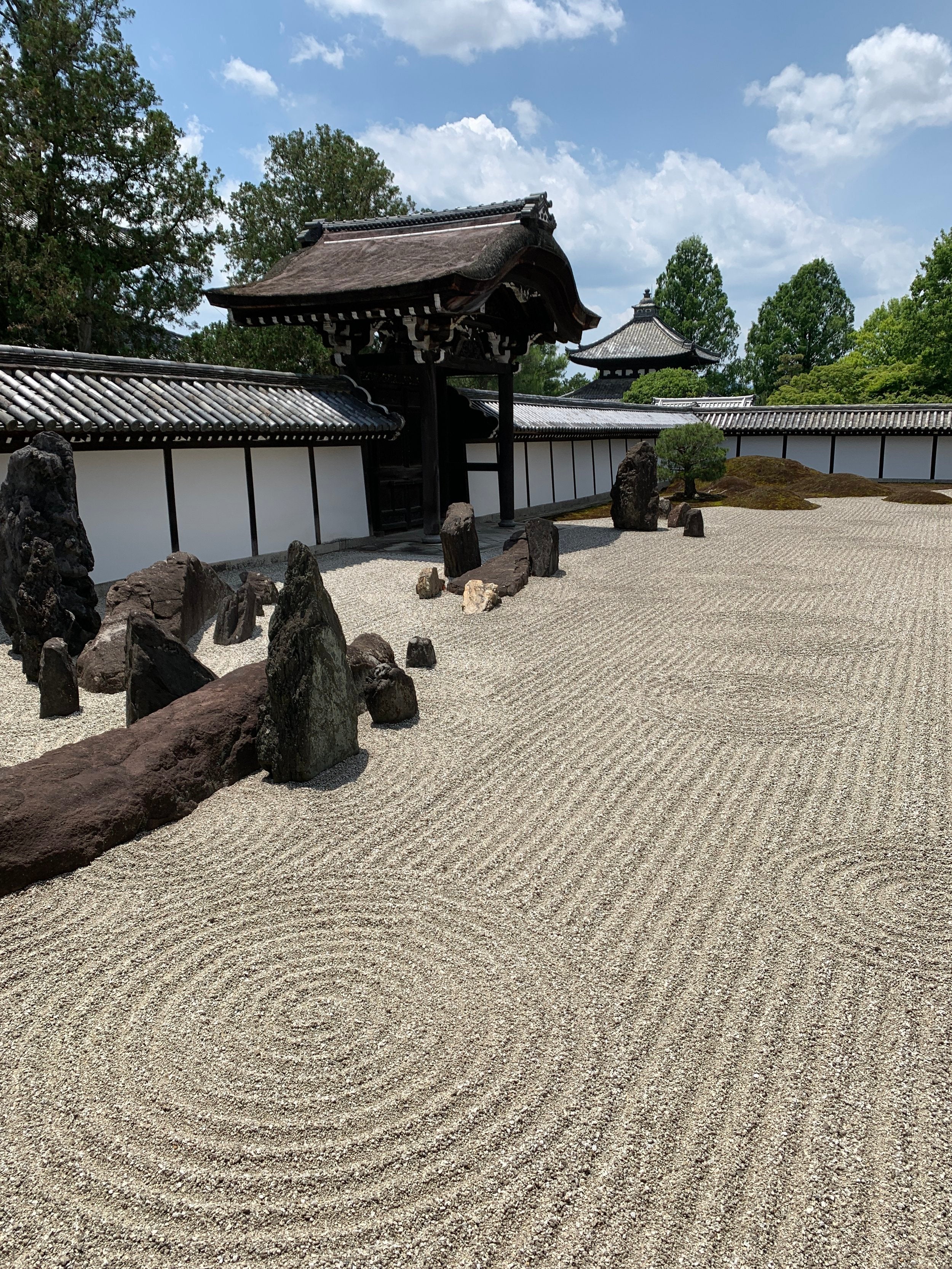I recently visited Tokyo and Kyoto for the first time in three years. I realised that I really need to see my family, friends, and business contacts there. I visited Marukyu Koyamaen and Ippodo’s head offices to discuss their teas, and I learned a lot from them! I also visited many beautiful gardens and temples in Kyoto, which I found very inspiring.
I always drink a cup of tea when I want to relax, calm down, sharpen my brain, or have an enjoyable time with my friends and family. I like to choose the right cups and sweets for each cup of tea. It’s lovely to be able to look at a nice garden, or flowers when I’m drinking my tea. That’s one of the main principles of the Japanese Tea Ceremony, where we use all five senses to enjoy tea.
If you haven’t been to Japan but are planning a trip, I recommend visiting Kyoto, especially Nanzenji and Tofukuji temples. Their zen gardens are very inspiring – I feel like my soul can rest and recharge. There is a gentle, but powerful, energy there. I didn’t have a cup of matcha while I was there, but it is a similar experience. I always feel calmed and recharged when I sit infront of the kama (iron pot) to make a cup of matcha tea. After all, the Japanese Tea Ceremony was developed in temples by monks as a zen ritual.
When I started practicing the tea ceremony, I didn’t like koicha (strong, thick matcha tea – almost like a paste), but enjoyed usucha (weaker, thin matcha tea – the type we drink most often) very much. Traditionally a cup of koicha is shared between guests, with up to five people drinking from one bowl. We wipe our lip marks from the bowl with kaishi paper (handmade paper, used like a napkin), before passing the bowl to the next guest. This has been the traditional since the 16th century. However, the tradition changed very recently in the 21stcentury, because of COVID-19! I joined a Chaji (very formal tea party) in Yokohama this May during my trip. The teacher there told me that the host now serves koicha to guests ones by one, and they have been doing it this way since spring 2020. I always thought that the traditional way was unfair to the fifth guest, as once the koicha gets to them it might be cold. I suppose this new way is more fair for the fifth guest! Still it was a little shocking that a centuries old tradition had been changed, and that I only just learned about it!
I thought now would be a good time to talk about how to drink matcha tea properly. Traditionally we drink matcha as usucha or koicha. Matcha lattes are not part of the tea ceremony. But I do like matcha lattes, matcha cake and matcha ice cream. I choose the highest grade of matcha tea for koicha, a slightly less high grade for usucha, and a lower grade for matcha lattes.
Koicha
Koicha is the most formal tea in the ceremony. We serve the main sweet dish (omogashi) before having koicha. Every guest finishes their sweets and is then ready for the strong taste of the koicha. As a lot of tea is consumed, so there is a very intense flavour, I recommend the very top grade of matcha tea be used for koicha. From our selection I recommend_
Marukyu Koyamaen_ Tenju, Choan, Eiju, Unkaku
As it is a very strong tea, I don’t recommend drinking more than two cups of koicha per day. I prefer to have one very nice koicha a day.
The method for koicha is as follows_
Matcha: 4g (3 bamboo teaspoons)
Hot water_ (80 °C) 30ml
Mix together slowly for 15 seconds.
Usucha
Usucha is the most popular matcha drink and is semi-formal for the tea ceremony. I usually drink three to four cups of usucha per day, as it is a very refreshing way to drink tea. Traditionally we serve dry and small, easy to bite sweets (higashi) before having a cup of usucha. You can enjoy a variety of grades of matcha as usucha, and I recommend the following from our collection.
Marukyu Koyamaen_ Tenju, Choan, Eiju, Unkaku, Kinrin, Kitsho, Low Caffeine
I know some Japanese people who like to drink top grades of matcha, like Kanza, Tenju, Choan and Eiju, as a stronger usucha tea – something like a cross between koicha and usucha – at home. These top grades are wonderful for both usucha and koicha. Personally, I wouldn’t use these top grade teas for a matcha latte, as the flavour of the milk overpowers the delicate flavours in the matcha, but of course it’s up to you!
The method for usucha is as follows_
Matcha: 2g (1 and a half bamboo teaspoons)
Hot water_ (80 °C) 70ml
Mix together vigorously for 15 seconds.
Matcha Latte
I recommend Aoarashi for magtcha latte lovers. This matcha is slightly bitter, so contrast wonderfully with the milk. If you use soy, almond or oat milk it’s also a great drink for vegans. Matcha contains high amounts of vitamin C and anitioxidants. An iced matcha latte is also very refreshing in summer!
The method for a matcha latte is as follows_
Matcha: 3g (2 and a half bamboo teaspoons)
Hot water_ (80°C) 90ml
Mix together vigorously for 15 seconds
Pour in your preferred milk
Iced Matcha
Finally, I want to suggest iced matcha tea this summer. I had so many different teas and discussed so many more when I visited Ippodo’s tea salon in Kyoto. It was a dream experience! Their matcha to-go packets are great to add to a bottle of water. Just shake the bottle and you’ve got cold matcha tea. It’s so travel friendly, and perfect for a hot summer holiday! When you use cold water, you can taste some of the sweetness of the tea, whereas hot water can accentuate bitter notes.
The method for cold shaken matcha tea is as follows_
Matcha: 2g (1 packet of matcha to-go tea)
Cold water_ 200ml
Shake it together in the water bottle vigorously.
Whichever you prefer, I hope this is useful for you, and that you might have learned something new! I hope that each tea time will help you slow down, rest your soul and recharge your energy! I’m going to have a cup of usucha and imagine I’m sitting in the Tofukuji zen garden right now…

